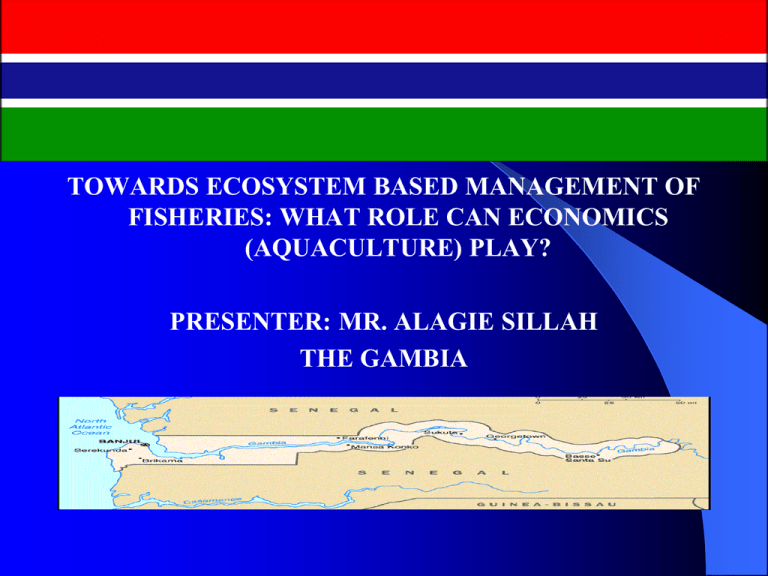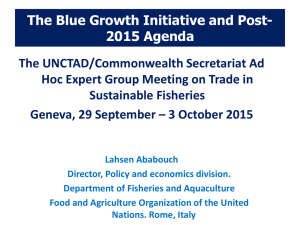TOWARDS ECOSYSTEM BASED MANAGEMENT OF FISHERIES: WHAT ROLE CAN ECONOMICS (AQUACULTURE) PLAY?
advertisement

TOWARDS ECOSYSTEM BASED MANAGEMENT OF FISHERIES: WHAT ROLE CAN ECONOMICS (AQUACULTURE) PLAY? PRESENTER: MR. ALAGIE SILLAH THE GAMBIA HOW WOULD AQUACULTURE INCREASE FISH CONSUMPTION IN THE GAMBIA Capture fisheries has ever been the only way fish and fishery products were accessed. Over the years, it was realized that if other methods are not applied it will not be viable / feasible any longer as fishing effort was increasing by the day. The intervention of aquaculture came as a result of the decline in capture fishery. HOW WOULD AQUACULTURE INCREASE FISH CONSUMPTION IN THE GAMBIA Therefore, its consumption was becoming lesser and lesser. With the emergence of aquaculture, production increased and many communities resorted to it and as a result, consumption increased. GOOD AQUACULTURE BREEDS-TILAPIA SPECIES Popular culture species are: Oreochromis niloticus, O. mossambicus, O. aureus Red Tilapia Tilapia Biology There are three important genera, Oreochromis, Sarotherodon and Tilapia (Trewavas, 1982, 1983) The most important distinguishing feature is the reproductive behaviour. Tilapia- nest builders Oreochromis niloticus – only Females do mouth brooding Sarotherodon – only the males or both males & females do mouth brooding. Culture Methods in the Gambia Tilapia is cultured in Semi-intensive and Extensive systems in the Gambia by using the following methods: Earthen Ponds Concrete Tanks Hapas They are cultured in both freshwater and brackish water No mono-sex culture is done at the moment. HOW WOULD AQUACULTURE PROVIDE FISH FOR THE LOCAL PEOPLE AT REASONABLE PRICES ? As the desire for the increase of fish production continues, it would be no more reliable to concentrate only on capture fishery. As we all know that when demand increases prices also increase because of scarcity. With the addition of aquaculture, this means that production will also increase and as it increases, there will be no room for scarcity any more and eventually prices lower and are therefore reasonable and affordable. CREATION OF JOB OPPORTUNITIES FOR THE YOUTHS AND WOMEN Youths and women are the most vulnerable in terms of employment. With the introduction at the local community level, they will seize the opportunity. Aquaculture being one of those productive sectors that offer prospects for immediate return on investments. A blessing in disguise for the youths and women. FOOD SELF SUFFICIENCY IN TERMS OF FISH PRODUCTION Aquaculture development, when pursued by the local community people, especially the youth and women will be an alternative to food self sufficiency. With the community participation, training farmers in construction methods and maintenance, tidal irrigational methods and access to loans. FOOD SELF SUFFICIENCY IN OF TERMS OF FISH PRODUCTION The development and growth of aquaculture hold great possibilities and is hoped to decrease or hold the country’s reliance on netted fish. This, coupled with shrimps and oyster culturing, has the potential to be economically and naturally feasible for the road to food self sufficiency. ERADICATES MALNUTRITION CAUSED BY INADEQUATE QUALITY NUTRIENTS IN DIET We are all aware of high content of nutritious nature of fish and fishery products. It is believed that malnutrition is caused by inadequate nutrients in diet. The more fish and fishery products we eat, the better chance we stand to distance ourselves from malnutrition. Food fish has a nutrient profile superior to all terrestrial meats. ERADICATES MALNUTRITION CAUSED BY LACK OF QUALITY PROTIEN IN DIET It is an excellent source of high quality animal protein and highly digestible energy, as well as an extremely rich source of Omega – 3 polyunsaturated fatty acids (PUFA’s) depending on the water medium; fatty soluble vitamins A, D & E; water soluble vitamins B complex; and minerals such as calcium, phosphorus, iron, iodine and selenium. In fact, if there is a single food that could be used to address all of the different aspects of world malnutrition, it is fish – the staple animal protein source of traditional fishers. INCREASE THE INCOME EARNING CAPACITIES OF THE PEOPLE IN THE FARMING AREAS It is agreed that the small-scale farmers have very limited earnings. With the inclusion of aquaculture into their businesses, their income earning capacities will increase. BRINGS DEVELOPMENT IN FISH FARMING COMMUNITIES As the youths and women engage in fish farming, their income increases which will help facilitate the development of their communities rapidly because they will be able to have more means of bringing development to their doorsteps DISCOURAGES MIGRATION OF PEOPLE FROM FISH FARMING REGIONS TO OTHER AREAS IN SEARCH OF JOB As aquaculture develops, it salvages the poor farming community of migrating to the coastal and city areas in search of jobs. As their engagement with aquaculture deepens, they begin to start forgetting to migrate. Migration carries high risk in leaving their families and properties behind. They will be tied down to their original homes, hence they will be able to support themselves. MAKING BEST USE OF THE NATURAL RESOURCES IN COUNTRY Land – certain areas which cannot be used for crop production can now be used for aquaculture. Water bodies – cages are installed in water bodies to raise fish. Utilization of by-products – certain by-products that are considered waste are used for fish feed. This may include utilization of forest products in fish feed. Wild fruits also can be incorporated in the fish feed. Resources that are not directly used by people can be used to prepare fish feed. REDUCES THE COUNTRY’S RELIANCE ON CAPTURE FISHERIES It is not disputable that today, there is an over-exploitation of fisheries resources because of numerous factors such as I.U.U. fishing, over use of fishing effort. With the emergence of aquaculture, effort on capture fisheries will decrease drastically. Conclusion In order to lead the way for a more sustainable aquaculture, the following steps below must be adhered to: Feed- quality and quantity should be available Soil and water quality- the soil should be able to retain water and both quality and quantity of water should be considered Seed- good quality seeds should be selected Training- locally based community people should be carefully trained as to how aquaculture is managed because of its sensitivity. THANK YOU VERY MUCH FOR YOUR UNDIVIDED ATTENTION








